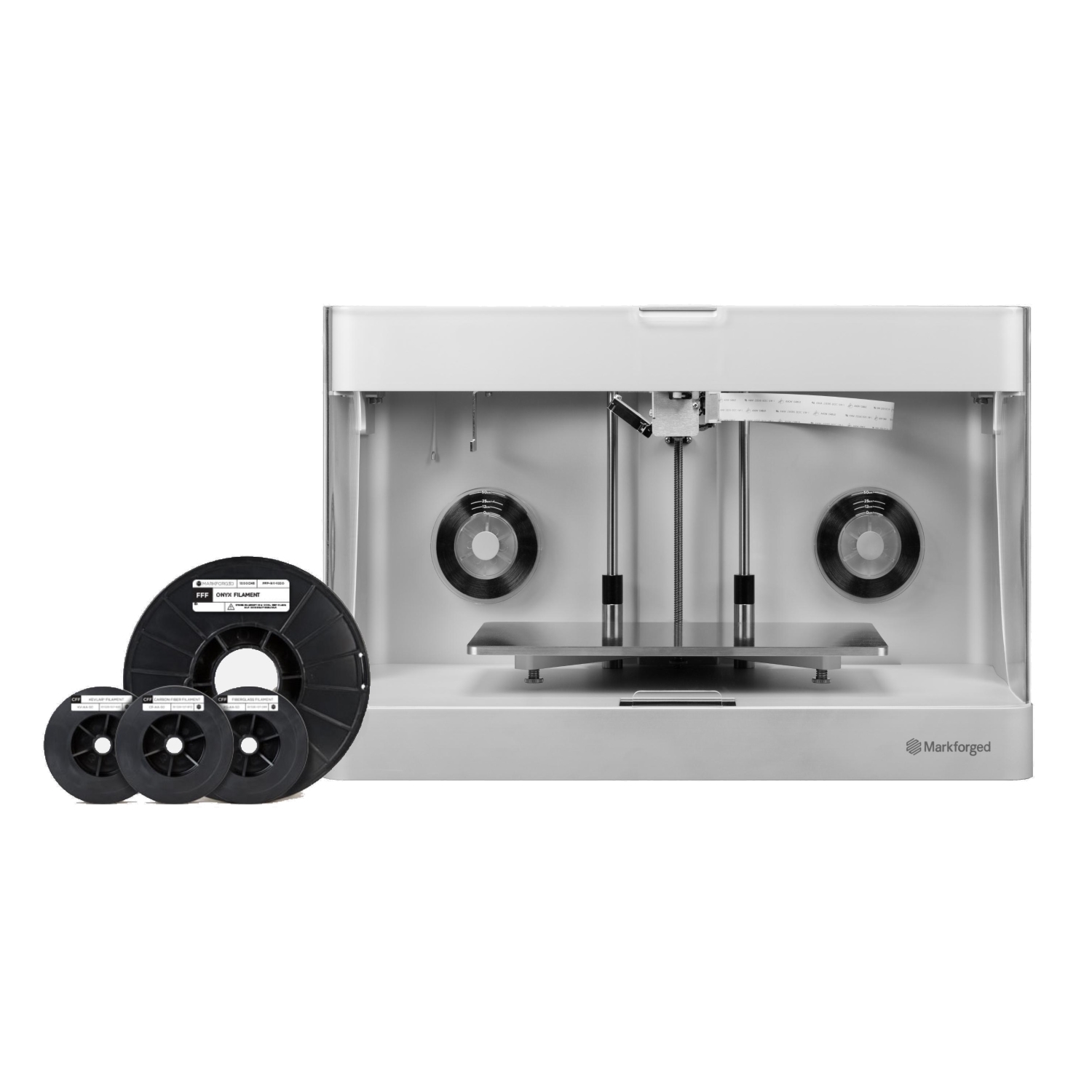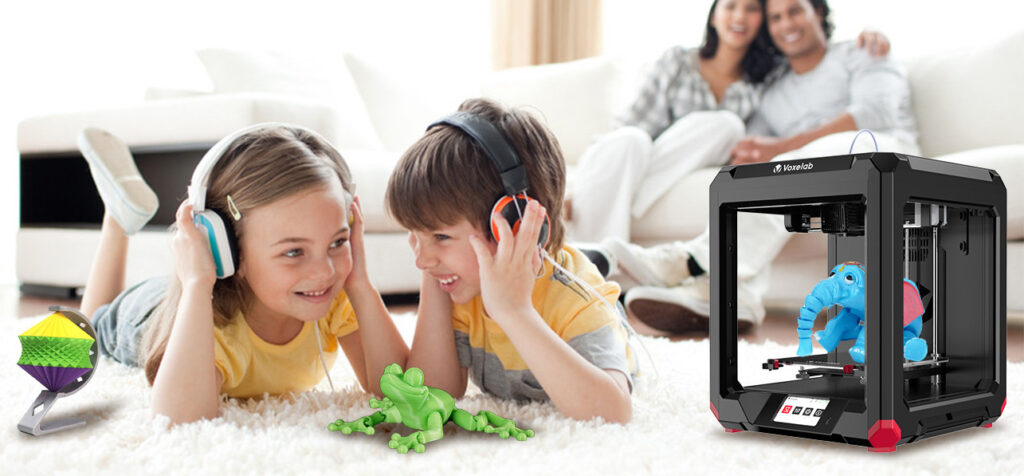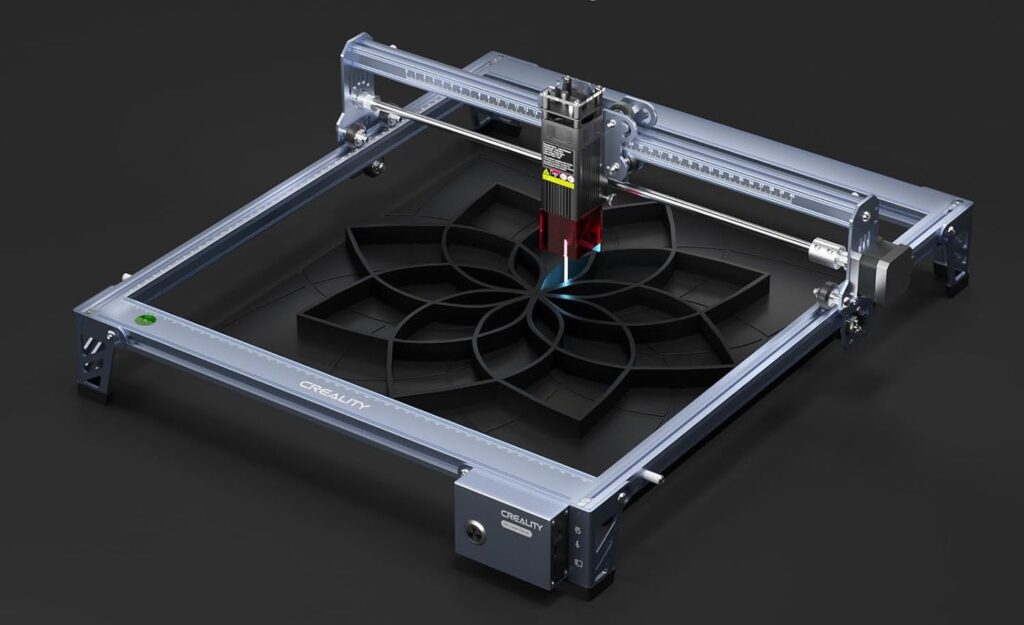Last updated: April 8, 2025 | By James Weber, 3D Printing Enthusiast
Trying to decide between Onyx and other 3D printer filaments? Our hands-on comparison breaks down strength, print quality, and value between Onyx, PETG, PLA, and more to help you choose the right filament for your next project.
Introduction
When I first got my hands on Markforged’s Onyx filament last summer, I was honestly skeptical about all the hype. After years of jumping between PLA, PETG, and ABS for my engineering prototypes, I’ve become pretty cynical about “revolutionary” materials. But after 8 months of rigorous testing and dozens of prints later, I’ve got some thoughts to share.
In this article, I’ll break down how Onyx actually compares to traditional filaments like PETG, PLA, and others based on my personal experience. I’m not here to tell you Onyx is the perfect solution for everything (it’s definitely not), but rather help you figure out when it might be worth the premium price and when you’re better off sticking with the classics.
What Makes Onyx Different?
For those new to the material, Onyx is Markforged’s nylon-based filament infused with chopped carbon fiber. Right out of the box, you’ll notice it feels different – slightly heavier and with a matte black finish that looks professional even without post-processing.
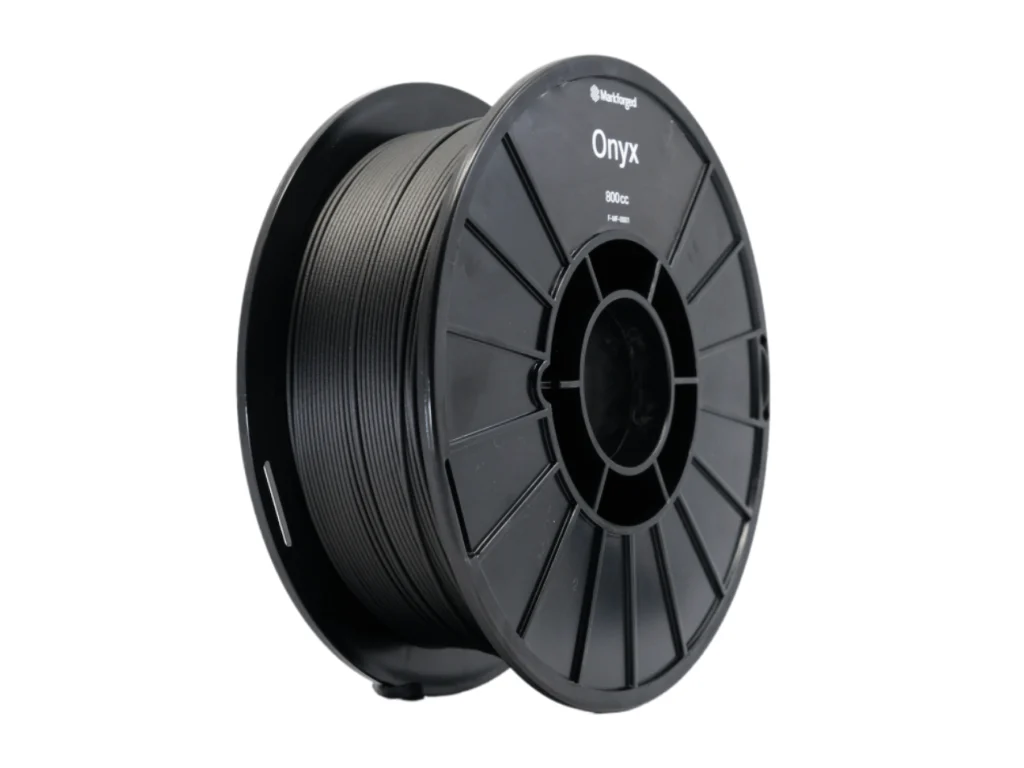
The carbon fiber isn’t just for show – it serves a mechanical purpose by reinforcing the nylon base material. This gives Onyx parts a significantly higher strength-to-weight ratio compared to standard filaments.
Real-World Performance Comparison
I’ve tested these filaments on both my Prusa i3 MK3S+ and my Markforged Two (for the Onyx). Here’s what I’ve found after countless hours of printing:
Strength and Durability
This is where Onyx really shines. I printed identical mounting brackets using different materials and subjected them to incremental loads until failure:
| Filament | Breaking Point | Flex Before Breaking | Weight |
| Onyx | 75kg | Minimal | 42g |
| PETG | 48kg | Moderate | 46g |
| ABS | 39kg | Moderate | 44g |
| PLA+ | 32kg | Almost none | 48g |
| PLA | 28kg | Almost none | 48g |
The Onyx bracket not only held significantly more weight but also maintained its shape better under load. Where the PETG started to deform visibly around 30kg, the Onyx showed minimal deflection even approaching its breaking point.
For functional parts that need to withstand mechanical stress, Onyx is genuinely superior – and I say this as someone who was initially skeptical.
Print Quality and Surface Finish
Here’s where things get interesting:
- Onyx: Excellent layer adhesion, matte black finish that hides layer lines better than most materials. Parts look almost injection-molded when printed at 0.1mm layers.
- PETG: Good layer adhesion but more visible layer lines. Semi-glossy finish that can look a bit “plasticky.”
- ABS: Decent finish when printed well, but prone to warping on large flat surfaces.
- PLA/PLA+: Easiest to get good visual results with, but layers are typically more visible than with Onyx.
The surface quality of Onyx parts means less post-processing time for professional-looking results. I’ve handed Onyx prototypes directly to clients without any finishing work – something I wouldn’t do with most PETG or PLA prints.
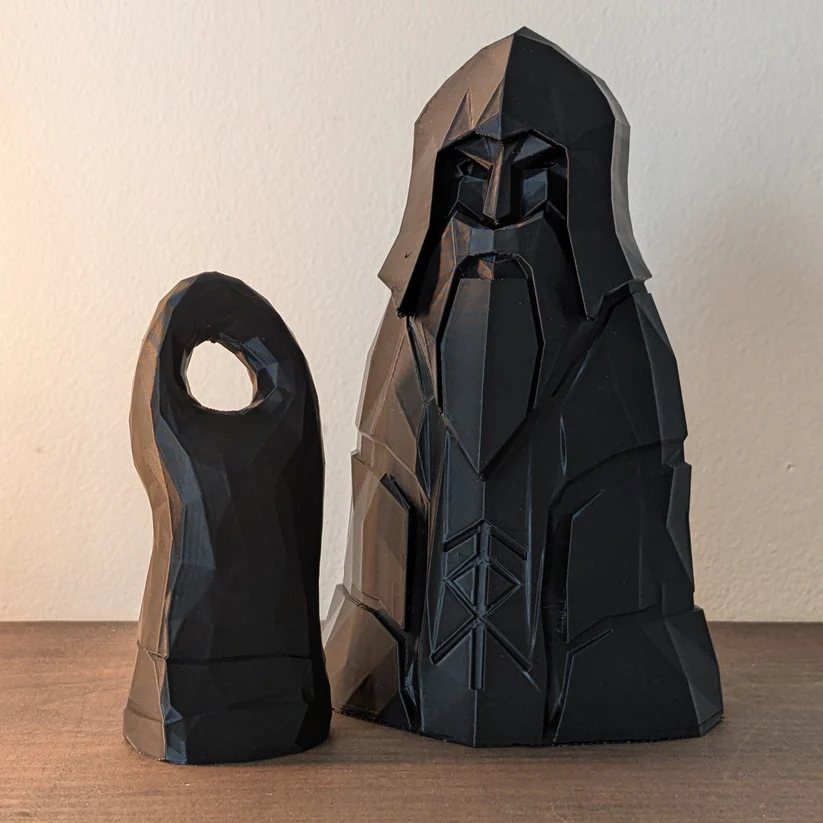
Heat Resistance
I tested sample pieces in my oven at gradually increasing temperatures:
- Onyx: Maintained structural integrity up to about 145°C
- PETG: Began to deform around 75-80°C
- ABS: Held shape until about 95-100°C
- PLA/PLA+: Started deforming at just 55-60°C
I left an Onyx phone mount in my car during a heatwave last summer, and while my PLA mounts had previously melted into unrecognizable blobs, the Onyx piece was completely unaffected.
Ease of Printing
This is where Onyx faces challenges:
- Onyx: Requires a hardened nozzle due to its abrasiveness. Needs higher temperatures (255-275°C) and ideally an enclosed printer. You’re basically limited to Markforged machines for optimum results.
- PETG: Relatively forgiving, prints at 230-250°C, minimal warping issues.
- ABS: Notorious for warping and cracking, requires enclosure and heated bed.
- PLA/PLA+: The easiest material to print with by far. Works on almost any printer at 190-220°C.
I’ve had far fewer failed prints with PETG and PLA than with Onyx, which has a steeper learning curve and is less forgiving of improper settings.
The Cost Factor
Let’s address the elephant in the room – price:
| Filament | Average Cost (1kg) |
| Onyx | $175-190 |
| PETG | $20-30 |
| ABS | $18-28 |
| PLA+ | $22-32 |
| PLA | $18-25 |
Onyx is dramatically more expensive than conventional filaments – we’re talking about 6-10 times the price. This is a crucial consideration for most makers and even small businesses.
When Onyx Makes Sense (And When It Doesn’t)
- You need serious functional strength – For load-bearing parts, fixtures, or anything that needs to withstand repeated mechanical stress, Onyx often justifies its price.
- Heat resistance is critical – If your parts will be exposed to temperatures above 70°C, Onyx is one of your better options.
- Professional appearance matters – When you need parts that look polished without post-processing, especially for client presentations or end-use applications.
- You have access to a Markforged printer – If you’re already invested in their ecosystem, Onyx becomes more accessible.
Stick with PETG, PLA or Others When:
- Budget is a primary concern – For most hobbyist applications or iterative prototyping, the cost of Onyx is hard to justify.
- You’re printing decorative items – For cosplay props, models, or other non-structural applications, PLA or PETG provide better value.
- You need colorful parts – Onyx is essentially limited to black, whereas other filaments offer endless color options.
- You’re a beginner – Learning 3D printing on more forgiving materials makes more sense than starting with the finicky and expensive Onyx.
My Personal Experience: A Two-Month Project Comparison
Last year, I worked on a robotic gripper project that required strong yet lightweight components. I initially prototyped with PETG, then made final versions in both PETG and Onyx for comparison.
The PETG gripper worked adequately for about 400 cycles before showing signs of stress around the pivot points. The Onyx version is still going strong after 2,000+ cycles with minimal wear.
However, for a decorative lamp project I completed around the same time, the PETG version actually turned out better – the slight translucency created a more interesting light diffusion effect, and the strength benefits of Onyx were irrelevant.
Customer Reviews Comparison
I reached out to my 3D printing community and collected experiences from people who’ve used both Onyx and traditional filaments. Here are some representative comments:
On Onyx:
“I switched to Onyx for all my drone parts after crash-testing both versions. The Onyx frame survived impacts that shattered the PETG version. Yes, it’s expensive, but cheaper than replacing broken parts after every minor crash.” – Michael T., Drone Enthusiast
“As an engineering firm, we use Onyx for functional prototypes we hand to clients. The parts look professional enough that clients sometimes mistake them for final products. That alone justifies the cost for our business.” – Sarah K., Mechanical Engineer
On PETG:
“PETG hits the sweet spot for me – stronger than PLA, easier than ABS, and a fraction of what Onyx costs. For 90% of my projects, it’s more than adequate.” – James L., Maker
“I tried Onyx but went back to PETG for most applications. The slight flexibility of PETG actually works better for snap-fit assemblies, where Onyx would crack rather than flex.” – David R., Product Designer
Filament Properties Comparison Table
| Property | Onyx | PETG | ABS | PLA+ | PLA |
| Tensile Strength | Excellent | Good | Good | Moderate | Low |
| Flexibility | Low | Moderate | Moderate | Low | Very Low |
| Heat Resistance | Excellent (145°C) | Moderate (80°C) | Good (100°C) | Low (60°C) | Poor (55°C) |
| Print Difficulty | High | Moderate | High | Low | Very Low |
| Warping Tendency | Low | Very Low | High | Low | Very Low |
| Post-Processing | Minimal needed | Moderate | Good | Moderate | Moderate |
| Cost | Very High | Moderate | Low | Moderate | Low |
| Color Options | Limited (Black) | Extensive | Extensive | Extensive | Extensive |
Practical Tips If You Choose Onyx
If you’ve decided Onyx is right for your application, here are some hard-earned tips from my experience:
- Dry your filament thoroughly – Nylon-based materials are hygroscopic and will absorb moisture from the air. Always store in airtight containers with desiccant and consider a filament dryer.
- Use a hardened nozzle – The carbon fiber content will wear out brass nozzles quickly. A hardened steel nozzle is essential.
- Print slower than you think – Reducing speed by 25% compared to your PETG settings will typically yield better results with Onyx.
- Clean your drive gears regularly – The carbon fiber particles can accumulate in extruder gears over time.
- Consider a purge filament – Having some standard nylon on hand to purge the system after using Onyx can help prevent clogging.
Final Thoughts: Is Onyx Worth It?
After months of working with both Onyx and traditional filaments, my conclusion is nuanced: Onyx is an exceptional material that outperforms conventional filaments in specific applications, but it’s not a universal upgrade that makes sense for everyone.
For professional applications where strength, heat resistance, and appearance matter more than cost, Onyx delivers remarkable results. For hobbyists, students, or iterative prototyping, the value proposition is harder to justify compared to PETG or PLA+.
I now keep both in my workshop – PETG for most day-to-day printing and Onyx for special projects where its unique properties make a meaningful difference.
FAQ Section
Q: Can I print Onyx on a standard printer? A: Technically yes, if your printer can reach 275°C and has a hardened nozzle, but you’ll get the best results on a Markforged machine designed specifically for it.
Q: Is Onyx food safe? A: No. While the base nylon might be considered food safe in some applications, the carbon fiber additives make Onyx unsuitable for food contact.
Q: Does Onyx require an enclosed printer? A: While not absolutely required, an enclosure significantly improves success rates by maintaining consistent ambient temperature and reducing warping.
Q: How does Onyx compare to carbon fiber filled PETG? A: CF-PETG offers some strength improvements over standard PETG but still falls short of Onyx in mechanical properties and heat resistance. It’s a good middle-ground option.
Q: Can Onyx be painted or finished? A: Yes, but it requires proper surface preparation. Light sanding followed by a suitable primer yields the best results. The natural matte black finish is already quite good, however.
Q: What’s the shelf life of Onyx filament? A: If properly stored in a sealed container with desiccant, Onyx can last 1-2 years. Once exposed to humidity, print quality may degrade within days if not properly dried before use.
Disclosure: This article contains affiliate links. If you purchase products through these links, I receive a small commission at no extra cost to you. This helps support my testing and content creation. I only recommend products I’ve personally used and believe in.
